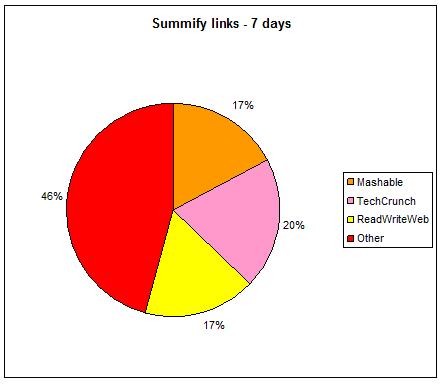I recently signed up for a new service called Summify that “creates a periodic summary of the most relevant news stories, from all of your social networks, and delivers it by email and on the web”. In short, Summify emails you links to stories that your network has shared during the last hours or days.
 When I first joined, I only connected my Twitter account to the service. After about one week I wanted to check what types of links Summify had sent me. I had chosen to get 5 links per day, but you can select another frequency and a different number of links. Turns out that a majority of the links are from TechCrunch, ReadWriteWeb and Mashable. In total, 19 out of 35 links are from these three sources.
When I first joined, I only connected my Twitter account to the service. After about one week I wanted to check what types of links Summify had sent me. I had chosen to get 5 links per day, but you can select another frequency and a different number of links. Turns out that a majority of the links are from TechCrunch, ReadWriteWeb and Mashable. In total, 19 out of 35 links are from these three sources.
For me, that is not very valuable. If you are the type of person that check Twitter on a regular basis, you will probably already have seen most of these stories. These three are among the most read social media and tech sites on the web so I have probably already seen the most interesting stuff from them. A typical link, like this one from Mashable, has been tweeted more than 1,400 times and shared 240 times on Facebook in less than a day. I had hoped that I would be exposed to links to stories that would be interesting to me, but that I probably hadn’t seen, not “most tweeted stories”.
On the other hand, you can use Summify as a filter to catch up on the stories that most people talk about. So if you are not a social media junkie who is on Twitter all day, Summify summarizes the most talked about stories, using your friends as a filter. Check Summify and you will be up to date with the latest news.
Now I have also added my Facebook and Google Reader accounts to Summify. Hopefully that will increase the number of sources that Summify sends to me. I will try to follow up this post in a few days to report if there has been any “improvement”.






